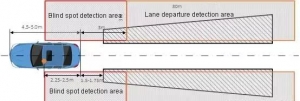This paper is to understand the differences of blind area monitoring, lane change assistance, blind area on the side of vehicle and lane offset
On the Internet, a consumer who bought accord posted a post saying that when he bought a car, he saw a blind area image system on the configuration table. He thought that he wanted a blind area monitoring system with an alarm light on the rear-view mirror to remind the driver. But after he bought the car, he found that it was not the same thing. He wanted to install a blind area monitoring system, which was very embarrassing.
Indeed, in the wave of the continuous development of intelligent driving, more and more intelligent driving subsystems are configured on the car. Not to mention that ordinary consumers can fully understand the functions and functions of these intelligent driving subsystems, even an intelligent driving Engineer may not be able to fully understand them.
Simply speaking from the aspect of lane change, there are different kinds of system names, such as blind spot monitoring system, lane change assistant system, parallel assistant system, Lane departure system and vehicle side blind area image system. If you only look at the name, you are totally confused. You can’t tell which name is the function you want.
For these kinds of systems used in lane changing, I will first classify them, and then classify them to explain the basic functions, which will help you better understand and choose the system you want. According to whether the system has alarm sound, the lane changing intelligent driving system is divided into two categories, as shown in the figure below.
1.Side blind area imaging system
The vehicle side blind area image system uses the camera installed at the designated position on the vehicle to capture the surrounding environment of the vehicle that the driver cannot see, and automatically displays it on the central control screen after reaching the trigger condition (generally turning on the turn signal).
Note: in the side blind area display system, there are two systems with the same name but different functions. Is it the same side blind area imaging system? There is such a big difference in functions that you have to see it clearly when you buy a car
2. Blind area monitoring system (parallel line auxiliary system) and lane changing auxiliary system
Before introducing the system, first popularize the GB 15084-2013 motor vehicle indirect vision device performance and installation requirements about the field of vision requirements of automobile rear-view mirror: the shaded part in the figure is the field of vision that the rear-view mirror needs to see.For the standard text requirements, I won’t do too much interpretation here. I will reconstruct this figure in combination with the size of passenger cars. The length of a general passenger car is 4.5-5.0 meters. After deducting the driver’s 2.25-2.5 meters from the rear of the car, the starting position of the field of vision of the rearview mirror is about 1.5-1.75 meters from the rear of the car, as shown in the following diagram.
It can be seen that a large part of the field of vision outside the rear-view mirror is the driver’s blind area. Combined with the ISO 17387 standard, the area on the rear side of the vehicle is divided into two areas: blind area monitoring and lane change assistance. This leads to the difference between blind area monitoring system and lane changing auxiliary system
Blind area monitoring system: it monitors whether there are obstacle vehicles in the 3M * 5.5m area behind the left and right sides of the vehicle. When there are obstacle vehicles, the blind area monitoring alarm light will give an alarm, and the driver can’t perform the steering action at this time.
Lane changing assistant system: it monitors whether there are potential dangerous vehicles in the area 3 * 30m behind the vehicle blind area, calculates the collision time according to the relative speed of the vehicle and self vehicle in the lane changing assistant area, and warns the driver whether there is danger when turning according to the collision time.
For the parallel line auxiliary system, it is the alias of the blind area monitoring system, and its function is completely consistent with the blind area monitoring system.
3. Lane departure system
Lane departure system uses the camera installed on the windshield of the vehicle interior rearview mirror to identify the lane line information. When the driver unconsciously (without turning signal) deviates from the lane, the system will emit a beep alarm sound, and the instrument will display which side of the lane line the vehicle deviates from.
If you are looking for reliable OEM ADAS BSD manufacturer, please feel free to email [email protected], we will offer professional & customized ASAS BSD solution at reasonable price.








